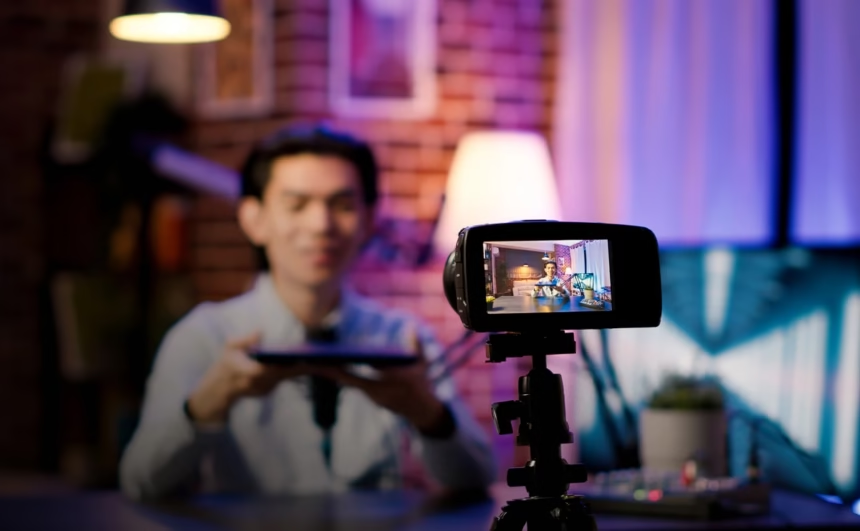Viral does not mean one lucky spike. It means high watch time, strong retention, and lots of shares. The best creators hit that mix on repeat by using simple psychology that works across TikTok, Reels, YouTube Shorts, and long-form videos.
This guide breaks viral growth into three parts: grab attention fast, make people feel and remember, and use trust and social proof so people share. Each tip comes with a clear action. No fluff, just what to try next. By the end, creators will have 10 psychology-backed moves to boost reach and retention. That is the promise behind viral video psychology.
Hook viewers in the first 3 seconds: curiosity, pattern interrupts, and motion
The brain scans for novelty and rewards quick clarity. In a feed, that means the first 3 seconds decide everything. The goal is simple. Stop the scroll, confirm the value fast, then move.
Short videos with rapid pacing and clear storytelling win more often in 2025. Many teams report strong results in the 15 to 30 second range for short-form, with rapid cuts and a clear payoff. The principle holds for long-form too. Nail the opening, then keep the pace tight.
Creators can move on to this today with the four moves below.
Spark curiosity with a question or tease the payoff
Curiosity rises when there is a tiny information gap. The viewer senses a missing piece, so the mind wants to close the loop. This is the curiosity gap at work. It is powerful, and it is simple to use.
Hook templates that work:
- “I tried X so others do not have to.”
- “Most people do Y, but here is what works better.”
- “Watch until the end to see if this beats the pro version.”
- “This 10 dollar tool outperformed the 200 dollar one.”
- “Everyone says this is wrong, here is why it might be right.”
Two key notes: deliver the answer inside the video, not in a follow-up, and pair the verbal hook with an on-screen visual teaser. For more examples and psychology insight, the tips in How To Make Engaging Videos: 6 Psychology-Backed Hacks show how curiosity, storytelling, and social proof support retention.
Break the pattern to stop the scroll.
A pattern interrupt is any unexpected shift that jolts attention. Start in motion. Jump into the middle of an action. Show an odd prop. Open with a tight close-up. Use a bold on-screen question that fills the frame. These small shocks wake the mind.
Quick examples to try:
- Hard cut from silence to a loud, crisp action.
- Sudden close-up on the key object, then pull back.
- On-screen text that asks a punchy question.
- Start with the result, then jump back to the setup.
Audit the first two seconds. Remove logos, “hey guys,” and slow intros. Replace them with action or a promise. For extra hook ideas, the guide on hooks that make your videos go viral includes strong openers that creators can adapt to different niches.
Use quick cuts and movement to hold attention.n
Motion pulls focus. Viewers track movement without thinking about it. That is why pacing matters so much in feeds full of autoplay clips. For short-form, aim for a cut every 1 to 3 seconds. Change framing. Add b-roll that matches the words at that moment.
A simple shot list thatworksn the opener action that shows the topic right away.
- A reaction face that conveys feeling.
- Over-the-shoulder to place the viewer in the scene.
- Top-down for steps, tools, or recipes.
Trim pauses that do not add value. Use captions for clarity. If a moment lags, add a quick zoom, swipe, or cutaway that feeds the point. For clean examples of pacing, “tiny stories” later in this post map well to these shots.
Make colours, music, and sound effects drive emotionColourss and sound set the mood before words land. Bright colours and punchy tracks add energy. Warm tones and softer music signal calm and care. Start music under the first line to avoid dead air. Time a beat drop or sting on the reveal.
A fast checklist:
- Clear voice, not buried by music.
- Balanced levels, no clipping.
- A short signature sting for brand memory.
- Captions for silent viewers, with key words highlighted.
For more principles on visual and emotional cues, see the breakdown of psychological triggers in 10 Psychological Hacks for Creating Engaging Videos. Those ideas map well to tcolourlor and sound choices listed here.
Make people feel and remember: story, emotion, and a satisfying payoff
Emotion connects to memory. Memory drives shares. When viewers feel something and can recall the point, they pass it on. Short videos can hit both by telling a tiny story, mixing strong feelings, and ending with closure.
Many viral clips today push one of three paths: awe and surprise, helpful fixes that save time or money, or a heartwarming turn that feels real. Aim for genuine moments, not hype. Fast, emotional storytelling tends to work better than sterile production alone.
Tell a tiny story with a clear beginning, middle, and end
Stories stick. A 20-second clip can carry a full arc. Use a small map.
- Problem: What is wrong or missing?
- Attempt: what the creator tries.
- Outcome: what changed.
A simple 3-line script:
- Line 1, hook: “This 5 dollar part fixed a 200 dollar problem.”
- Line 2, struggle or process: “I tried three fixes, then switched to this simple swap.”
- Line 3, result: “It worked in 2 minutes, and here is proof.”
Show change. Use before and after. Show wrong vs right. A tight story helps viewers remember the lesson and tells the brain this clip was worth the time.
Lead with strong emotions, people love to share
People share what feels amazing, helpful, or surprising. Focus on awe, delight, and practical relief. Those are safe and strong emotions that encourage comments and saves.
Examples that travel well:
- A simple fix that saves 10 minutes every morning.
- A wow reveal that flips a common belief.
- A heartwarming moment that shows kindness or skill passed forward.
Keep the tone thoughtful, not cheesy. Match the emotion to the topic. Add a small detail that grounds the moment, like a real-time reaction or a quick data point that supports the claim.
Recent guidance also points to high energy and clear likeability helping retention. Viewers mirror the creator’s energy, which boosts engagement and watch time. For more emotional triggers and formats, the summary in 18 Psychology Tricks to Get Viewers Addicted to Your Videos outlines patterns like common ground, proof, and relatable pain points.
Blend humour and insight so viewers feel happy and smarHumouror makes advice easier to accept. Insight gives the clip value. Together, they raise the odds of a save and a share.
Formats to try:
- “Myth vs fact” with a quick gag for the myth, then a clear fix.
- “3-second gag then lesson,” like a pratfall cut to the correct form.
- “Funny fail then what to do instead,” with a side-by-side of wrong and right.
Skip inside jokes that new viewers will not understand. Keep a wide door for first-time viewers. Add captions that land the punchline cleanly.
Pay it off with a surprise or satisfying re. vea.l
The mind seeks closure. If the hook opens a loop, the ending should close it. End with a twist, a step-by-step summary, or a strong visual after. Do not tease a result that never comes.
A quick payoff checklist:
- Answer the hook, straight and clear.
- Show proof, like a demo or a before-and-after shot.
- Invite one simple next step, such as save a comment on a keyword, or share with a friend who needs it.
Creators who end strong train viewers to trust their hooks. That trust lifts completion rates over time, which helps distribution.
Build trust and social proof so people share your video
Trust earns watch time. Social proof earns shares. Both are simple to show without bragging. Think proof first, posture second.
Show social proof cues to create FOMO and credibility
People use others as a signal for what is worth their time. Small cues go a long way. Add a fast montage of user results. Flash one or two comments that show outcomes. Use a subtle counter, like “2,000 saved this,” as on-screen text. Stitch or duet a reaction from a real user if the platform allows it.
Keep the caption short and clear. Hint at popularity without clickbait. A clean line like “Full steps in 20 seconds, save for later” does the job. For a broader list of social proof ideas and engagement tactics, this HubSpot piece on psychology-backed video hacks covers pattern interrupts and proof cues that pair well with short-form edits.
Use open hand gestures and matching body language.
Open palms signal honesty. Nods and gestures that match the words increase clarity. A simple setup works for most creators. Film at chest level, keep eyes near the lens, and use one clear gesture per key point. This creates a rhythm the brain tracks easily.
Tips to try:
- Start with hands visible, palms slightly open.
- Nod once when finishing a key line.
- Point or outline shapes that match the message, like drawing a box for “three steps.”
Relax the face. Smile with the eyes, not only the mouth. This small change boosts likability without feeling forced. If on-camera delivery is tough, study a few examples and practice with short clips. For inspiration and format breakdowns, this short guide to 3 hooks that make videos go viral shows how on-screen presence pairs with structure.
Quick production checklist to streamline workflow
A tight process supports all of the psychology above. Here is a simple checklist creators can use on repeat.
| Stage | What to do |
|---|---|
| Idea | Write one hook and one payoff in plain language |
| Script | Use the 3-line template, mark where the reveal lands |
| Visual plan | List 4 shots, note one movement per shot |
| Audio plan | Choose music, set levels low under the voice, mark a beat for reveal |
| Record | Film opener action first, then reactions and inserts |
| Edit | Cut all filler, add captions, and place sound cues on actions |
| Publish | Use a clear caption and one proof cue |
| Iterate | Watch retention, revise the first 3 seconds if the drop is sharp |
Examples creators can borrow today
- “Most people clean their lenses like this, but the safe way is easier. Watch the difference at the end.” Open with a tight shot of a smudged lens, then reveal the fix on the beat.
- “I tested three budget mics for under 30 dollars. One sounds like a studio.” Start mid-sentence with the best mic’s audio to interrupt the pattern, then show the lineup.
- “This five-minute tweak cut my morning routine in half.” Show a chaotic before, then the calm after with warm colours and soft music.
For even more templates and behavioural triggers, a creator-focused list like 18 Psychology Tricks to Get Viewers Addicted to Your Videos offers deeper prompts around pain points, proof, and timing. If a video example helps, this breakdown of a viral-format walkthrough can be seen here: 18 Psychology Tricks to Get Viewers Addicted to Your Videos.
Why these 10 tricks fit what works now
Across platforms in 2025, the data trend is clear. Fast hooks raise retention in the first 10 to 30 seconds. Emotional triggers like surprise, humour, and practical relief lift shares and comments. Pacing stays quick, especially for short-form, often with a cut every 1 to 3 seconds. Open loops can keep attention when the payoff is real, not bait. Authentic delivery beats stiff scripts.
Sound and colour matter because they front-load emotion. Social proof nudges a save or share when the viewer feels the content is already helping others. Small body language cues build trust without words. When creators stack these moves, watch time rises, which pushes distribution further.
Conclusion
Here are the 10 psychology tricks, in one glance: curiosity, pattern interrupt, motion and cuts, visual and audio cues, story, strong emotion, blended emotion, payoff, social proof, and hand gestures.
A simple 3-step plan:
- Write a sharp hook that opens a loop.
- Script a tiny story with a real payoff.
- Show proof so viewers feel safe to share.
Viral growth is not luck. It is a repeatable mix of clear hooks, strong feelings, and trust signals. Try one tip today, then share the results. Small changes stack fast when the goal is watch time and shares.














